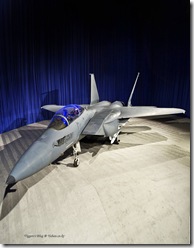F-15SE review
 ELP has a review of Boeing’s proposal for the F-15 Silent Eagle. Although primarily targeted to the export market, this aircraft could potentially be procured to swell the downsized ranks of USAF fighter squadrons:
ELP has a review of Boeing’s proposal for the F-15 Silent Eagle. Although primarily targeted to the export market, this aircraft could potentially be procured to swell the downsized ranks of USAF fighter squadrons:
Where the F-22 has already shown its ability to help legacy aircraft in air to air combat scenarios by seeing what targets its legacy team mate is locked on to, an F-15SE paired with the F-22 would give huge combat benefit. After the “next-war-itis” part of the war is over, the SE becomes an effective light bomber that can hunt anything all the way down to dirt insurgs as well as any combat jet ever made. Its sensor suite, two-aircrew setup, payload and fuel capacity make it a valued coalition fighter.
This, however, assumes that the USAF reverses its publicly stated policy of procuring only 5th-generation fighter aircraft in the future.
Naval Camo
Some just take littoral a little more seriously then others….



From the Top on Down: Indonesian Parchims/Kapitan Patimura’s, Finnish Hamina and Swedish Visby’s
IMINT & Analysis: New Chinese LPAR
SOC has an article on a newly constructed phased-array radar in western China:
he purpose of this radar system is not known, nor can it be determined by imagery alone. The location may provide some insight, as it is positioned in the western region. It may be positioned there to monitor Russian ballistic missile trials activity, or missile testing at Sary Shagan. Alternatively, it may be a space surveillance system intended to serve as a component in the developmental ASAT system.
An existing space-related LPAR has been identified in Xuanhua.
Return of the Skyraider?
Steve Trimble reports on the appearance of an interesting proposal by Air Tractor (a private US company) to convert its AT-802U crop-duster aircraft as a light COIN platform for employment in Iraq & Afghanistan.
The Air Tractor AT-802U is now en route from Olney, Texas, to Le Bourget, France, to be unveiled at the Paris Air Show, said Lee Jackson, design engineer.
Featuring an armored fuselage, a 10hr loiter time and the ability to haul more than 8,000lb of payload, unarmed AT-802Us have been operated by the US State Department in South America since 2002 eradicating drug crops, Jackson said.
Air Tractor is now offering the weaponized AT-802U Air Truck to the US Air Force and other militaries to serve as a a trainer/light attack fighter. After its international debut in Paris, the PT6A-67F-powered turboprop will return to Olney for a series of wepaons and sensor integration trials, he said.
To those who recall the very effective service of the A-1 Skyraider during the Vietnam conflict, the concept of a light prop-driven airframe as a COIN asset is likely to be welcome.
Russian navy to get big budget boost
Ares reports that the Russian navy, and particular its submarine force, is to get the lion’s share of the defense budget in the forthcoming years.
[…] more than 40% of the Defense Ministry budget will be spent on the navy, with emphasis on strategic nuclear forces.
“It is much more than is being spent on strategic missile forces, space forces and the air force combined. It is hundreds of billions of rubles”, said Ivanov, adding that the navy funding will be mainly spent for strategic nuclear submarines.
The focus on submarines comes as little surprise for those who have been watching the Russian navy’s budget over the lean years of the 90s and early 2000s; even when the funds were reduced to a trickle, submarines would snatch almost all of it (this BTW explains, to a significant extent, the collapse of virtually the entire surface fleet).
What is a surprise is that, overall, the navy is getting a significantly larger chunk of the overall budget this time around. Traditionally (including most of the Soviet period) the bulk of the budget was shared between the Strategic Rocket Forces, the Army and the Air Force, with the Navy getting the leftovers. It is possible that this shift signals a realization, from the Russian leadership’s part, of the growing importance of the naval arm in light of the emerging importance of the Arctic regions, as well as the new opportunities for influencing the trade routes emanating from China (it will be particularly interesting to watch the division of assets between the Northern and Pacific fleets in the coming years).
Interesting times indeed.





